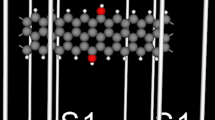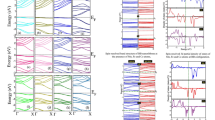Abstract
Using density functional theory, zigzag graphene nanoribbon (Z-GNR) saturated with hydrogen atoms decorated with copper clusters containing one, two and three copper atoms has been studied. It is shown that the cluster of copper, despite the number of copper atoms, tends to occupy the edge sites of Z-GNR. The quality and quantity of copper–carbon bonds, possible diffusion path and charge transfers are discussed in detail. It has been shown that in decorated Z-GNR with copper clusters, “d” and “s” orbital of copper joint with “p” orbital of carbon create a stable and strong bond. We show that copper in its individual form, transfers electrical charge to Z-GNR. In case of two and three copper atoms in a cluster, two different stable structures, stand and sleep-modes, are introduced. Based on number of copper atoms in a cluster and the modes that cluster stabilized on Z-GNR, the Fermi state in the decorated Z-GNR can shift to lower or higher energies. We also study the transformation from sleep to stand-mode and demonstrate that it is highly unlikely that any conversion happens at low temperatures.













Similar content being viewed by others
Notes
We check the activity of these structures for Hydrogen Sulfide. Stand-modes, in both cluster containing two and three atoms of copper, show more activity toward \(\hbox {H}_{2}\hbox {S}\).
We have checked this claim for cluster containing four copper atoms and it is correct.
References
Geim, A.K., Grigorieva, I.V.: Van der Waals heterostructures. Nature 499, 419–425 (2013)
Novoselov, K.S., Geim, A.K., Morozov, S.V., Jiang, D., Zhang, D., Dubonos, S.V., Grigorieva, I.V., Firsov, A.A.: Electric field effect in atomically thin carbon films. Science 306(5696), 666–669 (2004)
Yazyev, O.V.: A guide to the design of electronic properties of graphene nanoribbons. Acc. Chem. Res. 46(10), 2319–2328 (2013)
Castro Neto, A.H., Guinea, F., Peres, N.M.R., Novoselov, K.S., Geim, A.K.: The electronic properties of graphene. Rev. Mod. Phys. 81, 109–162 (2009)
Duttaa, S., Pati, S.K.: Novel properties of graphene nanoribbons: a review. J. Mater. Chem. 20, 8207–8223 (2010)
Novoselov, K.S., Geim, A.K., Morozov, S.V., Jiang, D., Zhang, Y., Dubonos, S.V., Grigorieva, I.V., Firsov, A.A.: Electric field effect in atomically thin carbon films. Science 306(5696), 666–669 (2004)
Kosynkin, D.V., Higginbotham, A.L., Sinitskii, A., Lomeda, J.R., Dimiev, A., Price, B.K., Tour, J.M.: Longitudinal unzipping of carbon nanotubes to form graphene nanoribbons. Nature 458, 872–876 (2009)
Berahman, M., Sanaee, M., Ghayour, R.: A theoretical investigation on the transport properties of overlapped graphene nanoribbons. Carbon 75, 411–419 (2014)
Subrahmanyam, K.S., Manna, A.K., Pati, S.K.: A study of graphene decorated with metal nanoparticles. Chem. Phys. Lett. 497, 70–75 (2010)
Li, W., He, Y., Wang, L., Ding, G., Zhang, Z.Q., Lortz, R.W., Sheng, P., Wang, N.: Electron localization in metal-decorated graphene. Phys. Rev. B 84, 045431 (2011)
Wu, M., Burton, J.D., Tsymbal, E.Y., Zeng, X.C., Jena, P.: Hydroxyl-decorated graphene systems as candidates for organic metal-free ferroelectrics, multiferroics, and high-performance proton battery cathode materials. Phys. Rev. B 87, 081406(R) (2013)
Li, Y., Pathak, B., Nisar, J., Qian, Z., Ahuja, R.: Metal-decorated graphene oxide for ammonia adsorption. Europhys. Lett. 103, 28007 (2013)
Gutés, A., Hsia, B., Sussman, A., Mickelson, W., Zettl, A., Carraro, C., Maboudian, R.: Graphene decoration with metal nanoparticles: towards easy integration for sensing applications. Nanoscale 4, 438–440 (2012)
Tjoa, V., Jun, W., Dravid, V., Mhaisalkar, S., Mathews, N.: Hybrid graphene-metal nanoparticle systems: electronic properties and gas interaction. J. Mater. Chem. 21, 15593–15599 (2011)
Zhang, C.X., He, C., Yu, Z., Zhang, K.W., Sun, L.Z., Zhong, J.: Transport properties of zigzag graphene nanoribbons decorated by carboxyl group chains. J. Phys. Chem. C 115(44), 21893–21898 (2011)
Berahman, M., Sheikhi, M.H., Zarifkar, A., Gebauer, R., Taheri, M., Asad, M.: H\(_{2}\)S Gas Sensor Based on Thin Film Graphene Nanoribbons Decorated with Copper: A First Principles Studies. Ultrafine Grained and Nano-Structured Materials, Tehran (2013)
Gorjizadeh, N., Kawazoe, Y.: Chemical functionalization of graphene nanoribbons. J. Nanomater. 2010, 513501 (2010)
Cao, C., Wu, M., Jiang, J., Cheng, H.P.: Transition metal adatom and dimer adsorbed on graphene: induced magnetization and electronic structures. Phys. Rev. B 81, 205424 (2010)
Wu, M., Liu, E.N., Ge, M.Y., Jiang, J.Z.: Stability, electronic, and magnetic behaviors of Cu adsorbed graphene: a first-principles study. Appl. Phys. Lett. 94, 102505 (2009)
Krasheninnikov, A.V., Lehtinen, P.O., Foster, A.S., Pyykkö, P., Nieminen, R.M.: Embedding transition-metal atoms in graphene: structure, bonding, and magnetism. Phys. Rev. Lett. 102, 126807 (2009)
Ning, Z., Chen, Z., Du, X., Ran, R., Dong, W., Chen, C.: Nickel Dimers Adsorbed on Graphene: First-Principles Study. J. Supercond. Nov. Magn. 26(12), 3515–3522 (2013)
Sevinçli, H., Topsakal, M., Durgun, E., Ciraci, S.: Electronic and magnetic properties of 3d transition-metal atom adsorbed graphene and graphene nanoribbons. Phys. Rev. B 77, 195434 (2008)
Rigo, V.A., Miwa, R.H., da Silva, A.J.R., Fazzio, A.: Mn dimers on graphene nanoribbons: ab initio study. J. Appl. Phys. 109, 053715 (2011)
Yu, G., Lu, X., Jiang, L., Gao, W., Zheng, Y.: Structural, electronic and magnetic properties of transition-metal embedded zigzag-edged graphene nanoribbons. J. Phys. D 46, 375303 (2013)
Longo, R.C., Carrete, J., Ferrer, J., Gallego, L.J.: Structural, magnetic, and electronic properties of Ni\(_{n}\) and Fe\(_{n}\) nanostructures (\(n\) = 1–4) adsorbed on zigzag graphene nanoribbons. Phys. Rev. B 81, 115418 (2010)
Asad, A., Berahman, M., Sheikhi, M.H., Pour, M.F.: Hydrogen sulfide gas sensor based on thin film carbon nanotubes/graphene nanoribbons. IR Patent No. 75,680
Weia, M., Chena, L., Lunb, N., Suna, Y., Lia, D., Pana, H.: Electronic and magnetic properties of copper-family-element atom adsorbed graphene nanoribbons with zigzag edges. Solid State Commun. 151(20), 1440–1443 (2011)
Berahman, M., Sheikhi, M.H.: Transport properties of zigzag graphene nanoribbon decorated with copper clusters. J. Appl. Phys. 116, 09370 (2014)
Giannozzi, P., Baroni, S., Bonini, N., Calandra, M., Car, R., et al.: QUANTUM ESPRESSO: a modular and open-source software project for quantum simulations of materials. J. Phys. 21, 395502 (2009)
Perdew, J.P., Zunger, A.: Self-interaction correction to density-functional approximations for many-electron systems. Phys. Rev. B 23, 5048 (1981)
Troullier, N., Martins, J.L.: Efficient pseudopotentials for plane-wave calculations. Phys. Rev. B 1991, 43 (1993)
Baishya, K., Idrobo, J.C., Öğüt, S., Yang, M., Jackson, K.A., Jellinek, J.: First-principles absorption spectra of Cun (n = 2–20) clusters. Phys. Rev. B 83, 245402 (2011)
Acknowledgments
M. B. thanks Dr. R. Gebauer (ICTP) for his valuable comments.
Author information
Authors and Affiliations
Corresponding author
Rights and permissions
About this article
Cite this article
Berahman, M., Sheikhi, M.H., Zarifkar, A. et al. Structural and electronic properties of zigzag graphene nanoribbon decorated with copper cluster. J Comput Electron 14, 270–279 (2015). https://doi.org/10.1007/s10825-014-0650-4
Received:
Accepted:
Published:
Issue Date:
DOI: https://doi.org/10.1007/s10825-014-0650-4




